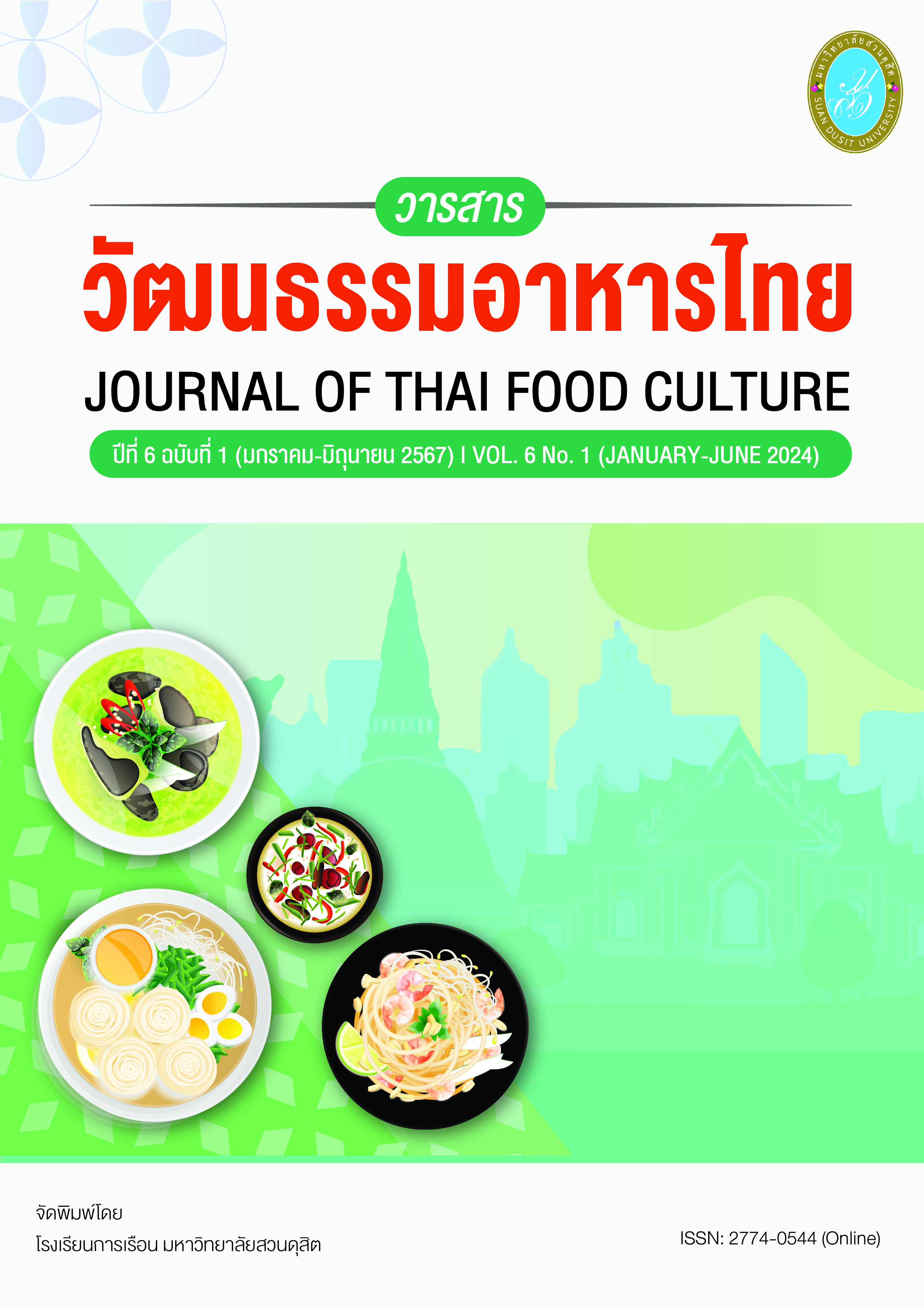ข้าวในวัฒนธรรมอาหารไทย
คำสำคัญ:
ข้าว, วัฒนธรรมอาหารไทยบทคัดย่อ
“ข้าวในวัฒนธรรมอาหารไทย” เป็นมรดกทางสังคมที่มีการเปลี่ยนแปลงตามยุคสมัย การรับประทานข้าวเกิดขึ้นก่อนสมัยอยุธยา จากหลักฐานทางประวัติศาสตร์พบว่าคนไทยรับประทานข้าวเหนียวเมล็ดยาว ใหญ่เป็นหลัก แต่ได้เปลี่ยนมานิยมรับประทานข้าวเหนียวเมล็ดเล็ก เรียว ยาว และส่งผ่านมาจนถึงปัจจุบัน นอกจากรับประทานข้าวเหนียวแล้วยังมีการบริโภคข้าวเจ้า ที่อินเดียเรียกว่า จาวัล มีลักษณะเมล็ด เรียว ยาว ในสมัยอยุธยาเป็นยุคทองของการพัฒนาวัฒนธรรมทางอาหาร จากเดิมที่รับประทานอาหารแบบเรียบง่าย กินปลาเป็นหลัก เปลี่ยนเป็นมีการต้ม แกง น้ำพริก และอาหารต่างชาติเข้ามา สมัยธนบุรีมีการทำนานอกฤดู สมัยกรุงรัตนโกสินทร์ยุคต้นกับยุคธนบุรี อาหารมีลักษณะเดียวกัน แต่มีอาหารเพิ่มขึ้นอีก 1 ประเภท คือ อาหารว่าง ตั้งแต่สมัยรัชกาลที่ 4 จนถึงปัจจุบัน อาหารมีความหลากหลายมากขึ้น ในปัจจุบันอาหารบางชนิดได้เปลี่ยนวิธี หรือเปลี่ยนส่วนประกอบไปจากเดิม ขาดความประณีตที่ถือว่าเป็นเอกลักษณ์ที่สำคัญของอาหารไทย ข้าว กลายเป็นสินค้าส่งออกที่สำคัญ เกิดการค้นพบ ข้าวขาวดอกมะลิ ที่นำไปปลูกในภาคอีสานและภาคเหนือ ได้ข้าวที่มีกลิ่นหอม เนื้อสัมผัสของข้าวสวย นุ่ม เป็นที่นิยม มีชื่อทางการค้าว่า ข้าวหอมมะลิ ซึ่งในปัจจุบันการบริโภคข้าวใหม่ ที่มีกลิ่นหอม ถือเป็นความท้าทายในการส่งต่อข้าวในวัฒนธรรมอาหารไทย
References
บรรณานุกรม
(1) กลุ่มเศรษฐกิจการประมง กรมประมง. (2565). บทความปลากะพงขาวและผลิตภัณฑ์, กรมการค้าระหว่างประเทศ
กระทรวงพาณิชย์. (ออนไลน์) เข้าถึงแหล่งข้อมูลได้จาก www.dtn.go.th สืบค้นเมื่อวันที่ 21 มิถุนายน
(2) ธนวรรณ นาคินทร์. (2556). เมนูปักษ์ใต้ หรอยจังฮู้. กรุงเทพฯ: สำนักพิมพ์แสงแดด. (ออนไลน์) เข้าถึงแหล่งข้อมูล
ได้จาก https://clib.psu.ac.th/southernfood. สืบค้นเมื่อวันที่ 21 มิถุนายน 2566.
(3) ศนิ สุวรรณศรี และคณะ.(2555). หนังปลากะพง, วารสารชุมชนศึกษา พลังชุมชน พลังเกาะยอ, (ออนไลน์) เข้าถึง
แหล่งข้อมูลได้จาก file:///C:/Users/User/Downloads/37977936.pdf สืบค้นเมื่อวันที่ 21 มิถุนายน
References
Ballantyne, R., Hughes, K., Ding, P. and Liu, D. (2014), “Chinese and international visitor
perceptions of interpretation at Beijing built heritage sites”, Journal of Sustainable Tourism, Vol. 22 No. 5, pp. 705-725.
Devid Mora, Miguel A. Solano-Sanchez, Thomas Lopez-Guzman, Salvador Moral-Cuadra. (2021).
Gastronomic Experiences as a Key element in the development of a tourist destination. International Journals of Gastronomy and Food Science; Volume25, October 2021, 100405. [Online] Access online in June 20, 2023.
Hansen, F., Kortbek, K. and Grønbæk, K. (2012), “Mobile urban drama”, New Review of
Hypermedia and Multimedia, Vol. 18 Nos 1/2, pp. 63-89.
Lebowitz, J. and Klug, C. (2011), Interactive Storytelling for Video Games, Elsevier, Amsterdam.
Moscardo, G. (2018), “Tourist experience design”, in Cai, L. and Alaedini, P. (Eds), Quality
Services and Experiences in Hospitality and Tourism, Emerald, Bingley, pp. 93-108.
Mathisen, L. (2013), “Staging natural environments”, Advances in Hospitality and Leisure,
Vol. 9, pp. 163-183.
Moscardo, G. (2017), “Stories as a tourist experience design tool”,
in Fesenmaier, D. and Xiang, Z. (Eds), Design Science in Tourism, Springer International
Publishing, Basel, pp. 97-124.
References
Moscardo, G. (2018), “Tourist experience design”, in Cai, L. and Alaedini, P. (Eds), Quality Services
and Experiences in Hospitality and Tourism, Emerald, Bingley, pp. 93-108.
Nika Razpotnik Viskovic, Blaz Komac. (2021). Gastronoic Tourism: A Brief Introduction; Acta
geographica Slovenica, 61-1, 2021, 95-105. [Online] Access online in June 21, 2023.
Sinha, A. and Sharma, Y. (2009), “Urban design as a frame for site readings of heritage
landscapes”, Journal of Urban Design, Vol. 14 No. 2, pp. 203-221.
Skinner, H., Sarpong, D. and White, G. (2018), “Meeting the needs of the millennials and
generation Z”, Journal of Tourism Futures, Vol. 4 No. 1, pp. 93-104.
UNWTO (2018), “Tourism highlights 2018 edition”, available
at: www.eunwto.org/doi/pdf/10.18111/9789284419876 (accessed 1 October 2018).
Xu, F., Weber, J. and Buhalis, D. (2014), “Gamification in tourism”,
in Xiang, Z. and Tussyadiah, I. (Eds), Information and Communication Technologies in Tourism 2014, Springer, Cham, pp. 525-537.
Yeoman, I. and McMahon-Beattie, U. (2019), “The experience economy”, Journal of Tourism
Futures, pp. 114-119.
Yash Chawla, Grzegorz Chodak. (2021). Social Media Marketing for Business: Organic
Promotions of Web-Lings on Facebook; Journals of Business Research, Volume 135, October 2021, Pages 49-65. [Online] Access online in June 20, 2023.
Downloads
เผยแพร่แล้ว
How to Cite
ฉบับ
บท
License
Copyright (c) 2024 โรงเรียนการเรือนสวนดุสิต

This work is licensed under a Creative Commons Attribution-NonCommercial-NoDerivatives 4.0 International License.
ลิขสิทธิ์ต้นฉบับที่ได้รับการตีพิมพ์ในวารสารวัฒนธรรมอาหารไทย ถือเป็นกรรมสิทธิ์ของโรงเรียนการเรือน มหาวิทยาลัยสวนดุสิต ห้ามผู้ใดนำข้อความทั้งหมดหรือบางส่วนไปพิมพ์ซ้ำ เว้นแต่จะได้รับอนุญาตอย่างเป็นลายลักษณ์อักษรจากโรงเรียนการเรือน มหาวิทยาลัยสวนดุสิต นอกจากนี้ เนื้อหาที่ปรากฎในบทความเป็นความรับผิดชอบของผู้เขียน ทั้งนี้ไม่รวมความผิดพลาดอันเกิดจากเทคนิคการพิมพ์

